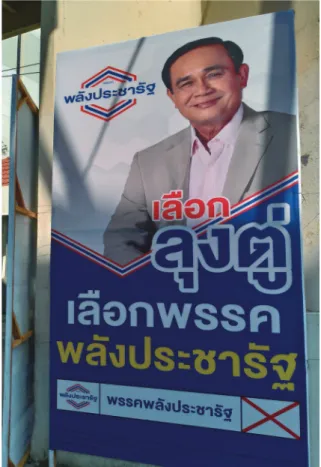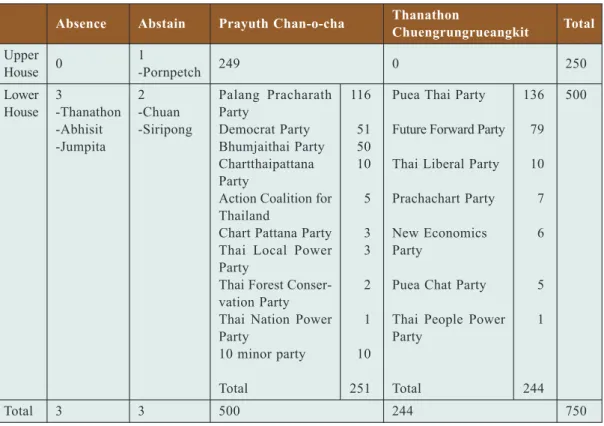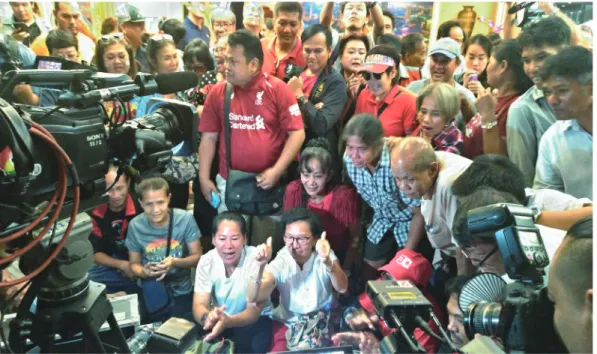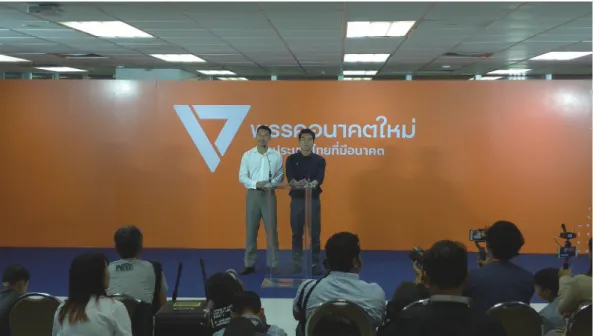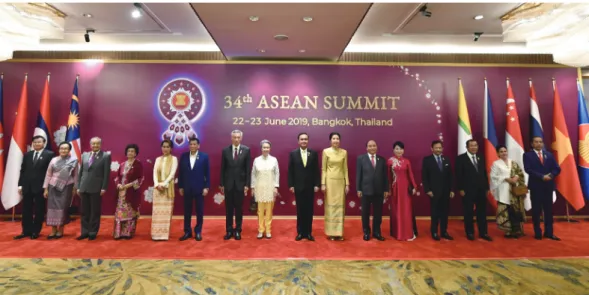The Implications of the 2019 Thailand
Election for the US Indo-Pacific Strategy
Shangmao Chen
Professor, Department of Public Affairs, Fo Guang University
Abstract
In March 2019, Thailand held its first effective election in eight years and elected the Palang Pracharat Party and General Prayuth Chan-ocha into office again. Noting strategic competition between the United States and China in Southeast Asia since 2008, the outcome of the Thai election holds great implications for great power relations and the Asia-Pacific region. Reviewing the election and the situation in Southeast Asia, this article claims that Thailand, caught between Washington’s and Beijing’s efforts to strengthen relations, will seek to adopt a balancing strategy that keeps both powers at equal distance while pursuing its own national interests. The author remains reserved over the development of Thai-US relations and more optimistic over Thai-Chinese relations. The article consists of five parts: part one reviews the recent Thai election; part two discusses the US Indo-Pacific Strategy and its implications for Thailand; parts three and four consider Thailand’s relations with China and Taiwan respectively; and part five concludes with some thoughts on the future of international relations in the Asia Pacific.
Keywords: Thai General Election 2019, Indo-Pacific Strategy, China Rising, Taiwan,
Great Power Competition
I. Introduction
On March 24, 2019, Thailand held its legislative election and elected a new group of 500 legislators. As the event was the first election since the military coup in 2014 – and eight years since the last effective election—all major parties in the country nominated candidates for the race. The outcome resulted in the Palang Pracharat Party, under military leadership, acquiring the support of about 8.4 million voters. The Puea Thai Party came in second, with about 7.9 million votes, followed by the
newly established Future Forward Party, Democrat Party and Bhumjaithai Party. Due to changes to the electoral system, the outcome demonstrated a proliferation of fragmented support with no party achieving more than half of the seats in the parliament. The Palang Pracharat Party and 19 other parties, in the end, jointly established a united cabinet.
After five years in power, General Prayuth Chan-ocha hoped to eliminate tensions between the red and yellow shirts through democratic election. In addition, through political and economic policies, the Prayuth government sought to marginalize the remnant influence of Thaksin Shinawatra and extend the rule of the military regime. While the seven opposition parties, including the Puea Thai Party, formed the pro-democracy camp and announced plans to for a coalition government after achieving more than half the seats in the parliament two to three days after the election, the
pro-democracy camp nonetheless failed to acquire dominant influence due to conflicts over the party list of candidates. Correspondingly, the Prayuth government succeeded in establishing a united cabinet. However, it should be noted that the 19 party strong cabinet only controls 254 seats, a majority of just three. Such a fragile coalition hints at various uncertainties for the Prayuth government in the future.
In the context of intense competition between the US and China, this article is an attempt to briefly consider the short term impact of the recent election on Thailand’s relationship with the US and China respectively. After reviewing the outcome of the election, the author considers what the continuation of the Prayuth government means for the US and China. The author remains reserved over the development of Thailand-US relations and more optimistic over Thailand-China relations. Washington may need to invest further efforts if it seeks to invite Thailand into the Indo-Pacific Strategy. This article concludes with some thoughts on the implications of the new developments in Thailand on Taiwan.
II. 2019 Thailand Election
According to the newly adopted constitution of 2017, the Thai parliament is made up of the Senate and the House of Representatives. The Senate has 250 seats, with senators serving in office for five years. Six Senate seats are reserved for important officials, namely the armed forces leaders, the supreme commander, the defense permanent secretary and the national police chief; 194 seats are appointed by the National Council for Peace and Order (NCPO); 50 seats are selected by the NCPO from a cohort of 10 professional and social groups, including state officials, teachers, judges, farmers, small and medium enterprises, women and minorities, and art and cultural practitioners. The Election Commission finalizes the appointment of the senators.
Figure 2. Future Forward Party Leader Speech before Election Night
Source: Photograph by the author.
The 2019 election elected 500 parliamentarians, who will serve for four years, under a mixed member proportional representation (MMPR) system, also known as the mixed member apportionment (MMA) system. Thailand shares a similar system with Germany with some differences. In the Thai system, 350 seats in the House are elected using a single district single vote system, dividing the country into 350 districts and electing one representative for each district. The other 150 seats are chosen from a party list. However, voters receive only the district vote. Seats from the party list are decided by the total distribution of votes in the country.
As the 2019 election is the first effective election since 2011 and the first election since the military coup in 2014, all parties in Thailand joined in the event. The recent election witnessed immense competition. Eighty parties nominated 10,792 candidates who ran for the 350 district seats, and 76 parties nominated 2,810 candidates who ran for the 150 party list seats. In addition, 44 political parties nominated 69 potential candidates for Prime Minister. According to the results released by the Thai Electoral Commission, there were 51,239,638 eligible voters, with 38,268,375 actual voter turnout, totaling 74.69%. Effective votes totaled 35,532,647 or 92.85% of all actual votes. Non-effective votes totaled 2,130,327 or 5.57% of votes. 605,392 votes “voted no”, 1.58% of votes. In the end, 26 parties gained seats in the parliament (see Table 1).
Table 1. 2019 Thai General Election Result
Rank Party Constituency Party List Total Seats
1 Puea Thai Party 136 0 136
2 Palang Pracharath Party 97 19 116
3 Future Forward Party 31 50 81
4 Democrat Party 33 20 53
5 Bhumjaithai Party 39 12 51
6 Thai Liberal Party 0 10 10
7 Chartthaipattana Party 6 4 10
8 Prachachart Party 6 1 7
9 New Economics Party 0 6 6
10 Puea Chat Party 0 5 5
11 Action Coalition for Thailand 1 4 5
12 Chart Pattana Party 1 2 3
13 Thai Local Power Party 0 3 3
14 Thai Forest Conservation Party 0 2 2
15 Thai People Power Party 0 1 1
16 Thai Nation Power Party 0 1 1
17-26 minor parties 0 10 10
Total 350 150 500
Source: Election Commission of Thailand,
“࠸࠸ࡌ.ࡒ࡚ࡧ࠸ࡩࡓ࠸ࡩ࡚ࡳࡤ࠸ࡌ࠾ࡼࡨࡡࡘࡩࡁ࠸ ࡡࡗࡩࡓᕎࡰࡴࡎࡐ࡚ࡩࡠࡅ࡚ࡴࡑࡑࡑࡨࡄࡁ࡚ࡩ࡙ࡁࡤࡻ ,” August 21, 2019, accessed, Election Commission of Thailand, <https://www.ect.go.th/ewt/ewt/ect_th/download/article/ar-ticle_20190508184334.pdf>.
After the election result was officially announced, the parliament elected the country’s Prime Minister on June 5. From a total of 750 seats, 747 members cast their votes, while three members refrained (see Table 2). The Election Commission canceled Thanathon Chuengrungrueangkit’s (Future Forward Party, FFP) right to vote due to his stocks in media corporations. Jumpita Chantarakachon of the FFP was absent from the vote due to illness, while Abhisit Vejjajiva of Democrat Party resigned from office. General Prayuth received the support of 500 of the 747 members of parliament, 249 votes from the upper house and 251 votes from the lower house, to successfully become the new prime minister. Pornpetch Vichitchonchai, speaker of the upper house, abstained from the vote while Chuan Leepai of Democrat Party, speaker of the lower house, and Siripong Angkasakulkiet of the Bhumjaithai Party abstained as well. The opposition camp nominated Thanathon Chuengrungrueangkit for the event, who claimed 244 of the 246 seats in the alliance (the two missing seats were Thanathon himself and his fellow member who was ill).
Table 2. Prime Minister Election Result
Absence Abstain Prayuth Chan-o-cha ThanathonChuengrungrueangkit Total
Upper House 0 1 -Pornpetch 249 0 250 Lower House 3 -Thanathon -Abhisit -Jumpita 2 -Chuan -Siripong Palang Pracharath Party Democrat Party Bhumjaithai Party Chartthaipattana Party
Action Coalition for Thailand
Chart Pattana Party Thai Local Power Party
Thai Forest Conser-vation Party Thai Nation Power Party 10 minor party Total 116 51 50 10 5 3 3 2 1 10 251
Puea Thai Party
Future Forward Party
Thai Liberal Party
Prachachart Party
New Economics Party
Puea Chat Party
Thai People Power Party Total 136 79 10 7 6 5 1 244 500 Total 3 3 500 244 750
The political situation of Thailand was largely set after the election of the prime minister, with the Palang Pracharat Party forming the new cabinet while in control of over half of the seats in the House. Out of 254 seats, the Palang Pracharat Party contributed 116 seats, the Phak Prachathipat Party 53 seats, the Bhumjaithai Party 51 seats, the Thai Liberal Party 10 seats, the Action Coalition for Thailand five seats, the Chart Pattana Party three seats, the Thai Local Power Party three seats, the Thai Forest Conservation Party two seats and the Thai Nation Power Party one seat. Ten other small parties also contributed one seat each. King Vajiralongkorn approved the Prayuth cabinet on July 10, signaling the official commencement of Thailand’s new government. As 2019 coincides with the turnover of Association of Southeast Asian Nations (ASEAN) chairmanship to Thailand, how the Prayuth government will maintain relations in the region remains to be seen.
Figure 5. Crowd Watching the Election in Puea Thai Party Headquarters
Figure 6. Future Forward Party Press Conference after the Election
Source: Photograph by the author.
III. US Indo-Pacific Strategy and Thailand
Under the leadership of the Donald Trump administration, since 2016, the US has shifted its foreign policy focus towards the Indo-Pacific region, expanding Washington’s traditional focus on the Asia-Pacific by enlarging the scope to encompass the Indian Ocean region. In a sense, the Indo-Pacific Strategy is an extension of the rebalancing strategy initiated under the preceding Barack Obama administration, which moved US foreign policy attention from the Middle East toward the Asia Pacific. As such, the Obama administration invested much effort in deepening relations with allies and friends and re-boosting America’s presence in the region, most notably consolidating relations with Japan, South Korea, India and Indonesia, establishing the Trans-Pacific Partnership (TPP), and proclaiming the US policy to maintain freedom of navigation in the South China Sea. The rise of China in the new century was a key driving force behind the Obama administration’s strategic turn toward Asia, in contrast with the focus on the War on Terror of the preceding administration.
Nonetheless, while the Trump administration has maintained Washington’s continued foreign policy focus on Asia and balancing China’s rise remains a key objective, marked differences exist between the Indo-Pacific Strategy and the Rebalance to Asia,1or
Asia-Pacific strategy. The fact that the Indo-Asia-Pacific Strategy was proposed while Washington called for partner states to shoulder more defense responsibilities is a signal that US security umbrella cannot be fully counted on. Such transformation demands Japan and South Korea in particular burden more of the cost for maintaining US troops in the two countries,2which stands in contrast with the Obama administration’s consolidation of
relations with Japan and Korea. Despite attending the ASEAN Summit in 2017, President Trump missed the 2018 summit in Singapore, meanwhile tensions escalated in the South China Sea. Not only did Trump’s absence waver the confidence of ASEAN countries in the US, Washington’s firm position on the Freedom of Navigation (FON) sacrificed the security of Southeast Asian countries amid clashes with China.
Figure 7. U.S. Secretary of Commerce Wilbur Ross Met with Thailand Prime Minister Prayuth Chan-o-cha
Source: U.S. Embassy, “U.S. Secretary of Commerce Wilbur Ross in Bangkok, Thailand,” September 28, 2017, Flickr, <https://www.flickr.com/photos/usembassybkk/37336576812/in/photostream/>.
On the US rebalance strategy under the Obama administration, see David Shambaugh, “Assessing the US ‘Pivot’ to Asia,” Strategic Studies Quarterly, Vol. 7, No .2, pp. 10-19.
Coupled with seemingly decreasing US commitment to security in Asia is the revived competition between regional views. Through the Indo-Pacific Strategy, the US seeks to shape an environment and vision that differs and rivals the East Asian conception favored by China; such competition bears semblance to the strategic competition between the TPP and the Regional Comprehensive Economic Cooperation (RCEP) a few years back. It is against such backdrop that Southeast Asian countries, under the leadership of Thailand, adopted the ASEAN Outlook on the Indo-Pacific at the 2019 ASEAN summit. As an alternative to the American and Chinese conceptions, Prayuth noted that “Asia, the Pacific and the Indian Ocean must not be seen as a divided territory, but as a contiguous and closely integrated and interconnected region, with ASEAN playing a central and strategic role.”3Prayuth further stressed that “the
Indo-Pacific region should be seen as a region of dialogue and cooperation instead of rivalry, and it should be seen as a region of development and prosperity for everyone.”4Specifically, he highlighted “the importance of the maritime domain, and
the need to constantly review not just the document, but also the entire regional architecture, which is constantly evolving.”5
According to the official statement released at the summit, the ASEAN Outlook aims to (1) offer an outlook to guide cooperation in the region; (2) help to promote an enabling environment for peace, stability and prosperity in the region in addressing common challenges, upholding the rules-based regional architecture, and promoting closer economic cooperation, and thus strengthen confidence and trust; (3) enhance ASEAN’s Community building process and further strengthening the existing ASEAN-led mechanisms, such as the East Asia Summit; and (4) implement existing and to explore other ASEAN priority areas of cooperation, including maritime cooperation, connectivity, the Sustainable Development Goals (SDGs), and economic and other possible areas of cooperation.6
The Japan Times, August 8, 2019, <https://www.japantimes.co.jp/news/2019/08/08/asia-pacific/ trumps-push-south-korea-pay-u-s-troops-puts-japan-notice/#.XV_8XugzZPY>.
Kornchanok Raksaseri & Thana Boonlert, “Sights set on Indo-Pacific,” Bangkok Post, June 24, 2019, <https://www.bangkokpost.com/thailand/general/1700540/sights-set-on-indo-pacific>.
Kornchanok Raksaseri & Thana Boonlert, “Sights set on Indo-Pacific.” Kornchanok Raksaseri & Thana Boonlert, “Sights set on Indo-Pacific.”
ASEAN, “ASEAN Outlook on the Indo-Pacific,” June 22, 2019, ASEAN, <https://asean.org/ storage/2019/06/ASEAN-Outlook-on-the-Indo-Pacific_FINAL_22062019.pdf>.
Serving as the chair of ASEAN in 2019, Thailand plays an important leadership role in realizing the ASEAN Outlook—Bangkok’s performance in foreign relations in the near future will inevitably define the tone of the outlook. While the ASEAN Outlook harbors a more expansive vision of the Indo-Pacific region, it is interesting to note that both the US and Japan—influential powers in Southeast Asia—share a more limited view of the region that subtly hints at the exclusion of China. Whether the ASEAN Outlook can become the common denominator for cooperation among stakeholders in the region, including major powers, is an issue worthy of further debates and observations.
Figure 8. 34th ASEAN Summit
Source: Prime Minister’s Office Singapore, “34th ASEAN Summit-Jun 2019,” June 23, 2019, Prime Minister’s Office Singapore, <https://www.pmo.gov.sg/Photos/34th-asean-summit-jun-2019>.
IV. Implications for Thailand-US Relations
As noted by observers, despite the US pivot to Asia since the Obama administration, the status of Thailand in US foreign policy seems to have declined due to Washington’s emphasis on other states in the region. Perhaps the sheer size of India and Indonesia made the two countries the top priorities for US engagement, while Myanmar, Vietnam and the Philippines complete the containment strategy against China. Meanwhile, perhaps also due to Thailand’s neutral position in the South China Sea dispute—an
issue that both the Obama and Trump administration have used as a check against China—the strategic value, or put more blatantly, room for the US to maneuver against China, is greatly undermined. Furthermore, domestic political turmoil, namely the coup d’etat that led to the suspension of democratic elections in the country, makes Thailand a difficult partner to work with in the eyes of the US. In the name of democracy, in 2012, Japan’s Shinzo Abe proposed a Democratic Security Diamond that drew together cooperation between Japan,7the US, Australia and India, and which
corresponded with the Quadrilateral Strategic Dialogue (QUAD) that was revived by the four countries in 2017. In light of the call for democracies to cooperate, Thailand’s political status ironically stood closer to China’s position despite its good relationship with members of the QUAD.
Therefore Thailand’s return to democratic elections, in some sense, offers a potential breaking point for hitherto lukewarm bilateral relations. Regardless of future development, at least in the short term, the election provides both reason and legitimacy for Washington to strengthen relations with Thailand. While Prayuth’s embracing of democracy provides good support for the Trump administration to rekindle relations with Thailand based on a claim to similar political values between the two countries, the establishment of domestic political stability in the latter gives Washington a good strategic partner to work with in the region, in terms of checking the influence of China.
In a region where states have been increasingly leaning towards China economically —as evidenced by the Second Belt and Road Forum (BRF) in 2019—military security perhaps remains the only aspect where the US can effectively counterbalance Chinese influence. Since 1982, the US and Thailand have cooperated in Cobra Gold, a joint military and humanitarian assistance exercise held in Thailand every year, which has grown into the largest exercise in the Asia-Pacific over the past three decades. Meanwhile, in 2017, Washington approved the sale of RGM-84L Harpoon Block II anti-ship missiles and four Black Hawk helicopters to Thailand, and just two months after the election in 2019, the Thai army confirmed the purchase of 37 Stryker infantry Shinzo Abe, “Asia’s Democratic Security Diamond,” Project Syndicate, December 27, 2012, <https://www.project-syndicate.org/commentary/a-strategic-alliance-for-japan-and-india-by-shinzo-abe?barrier=accesspaylog>.
carrier vehicles from the US.8It is clear that US military influence remains strong in
the region and serves as a counter weight against growing Chinese influence in Southeast Asia.
Figure 9. The Aircraft Carrier USS Nimitz Prepare to Depart from Phuket, Thailand
Source: Commander, U.S. 7thFleet, “Electronic Attack Squadron 142 on the flight deck of the aircraft carrier USS Nimitz,” Flickr, <https://www.flickr.com/photos/us7thfleet/8945745455/>. For Thailand, in light of the opportunity to renew relations with the US, current conditions may not be particularly favorable to deepen bilateral relations. Noting the constant geopolitical threat of China and Thailand’s role as the new chair of ASEAN, consideration for regional interest may encourage the Prayuth government to hedge between the US and China and balance relations with the two powers. Balancing major powers has long served as the dominant strategy for Southeast Asia, so there is little reason to imagine Thailand would do otherwise. On the other hand, the volatility of US foreign policy under Trump and the trade war between the US and China suggest that Thailand should remain at arm’s length from both countries to some extent. The case of Japan, a country with close relations with Thailand, is telling. Close relations with the US did not protect Japan from suffering from the US-China
Prashanth Parameswaran, “New Military Vehicle Deal Approval Puts US-Thailand Alliance in Focus,” The Diplomat, July 31, 2019,
<https://thediplomat.com/2019/07/new-military-vehicle-trade war. Having lukewarm relations with the US may actually be helpful for Thailand, as excessive leaning toward the US may risk involving Thailand in great power conflicts with marginal benefits. In such light, it remains to be observed whether Thai-US relations will improve significantly in the near future and whether Thailand will play an increased role in the US Indo-Pacific Strategy. As the US seeks to balance China, Thailand seeks to balance the US with China while maintaining the interests of ASEAN.
V. Implications for Thailand-China Relations
With Prayuth remaining in power, one can expect Thailand to continue to maintain good relations with China. Despite sitting out of the First BRF two years ago, Prayuth attended the recent BRF, while Thailand’s Minister of Transport pronounced the desire for bilateral negotiations on the Thai-Chinese high speed railway to pick up pace9—
both signs that Bangkok has shifted its foreign policy stance away from the US and towards China in recent years. Nonetheless, Chinese ambition to project cultural influence into Thailand through the Belt and Road Initiative (BRI) has caused the Thai Foreign Ministry to look onto the Chinese initiative and underlying strategy with a suspicious eye. As Thai foreign policy is traditionally quite flexible, it remains to be seen whether Thailand will swing towards the US again, particularly in light of Washington’s renewed interest in bringing up relations with Bangkok. Meanwhile, China hopes to push for the establishment of the South China Sea Code of Conduct (COC) while Thailand holds the ASEAN chair. As a non-claimant in the South China Sea however, Thailand shows little motivation to move discussions on the COC.
A spotlight in Thai-Chinese relations that warrants attention, however, is the increased military sales from China to Thailand. Since the US scaled back cooperation after the military coup in 2014, as Ian Storey points out, Beijing has filled a void in Thailand’s arms imports by not only agreeing to provide Thailand with three diesel-electric submarines for US$1.03 billion, but also battle tanks, armored personnel
Patpicha Tanakasempipat & Panu Wongcha-um, “Thailand says ‘making progress’ with high-speed Thai-Chinese railway,” Reuters, April 24, 2019, <https://www.reuters.com/article/us- china-silkroad-thailand-railway/thailand-says-making-progress-with-high-speed-thai-chinese-railway-idUSKCN1S01F8>.
carriers, artillery locating radar and surface-to-air missiles.10 While the submarine
transfer is the biggest national defense deal in the history of Thailand, as the country faces relatively little security threats compared to other neighboring countries, China’s provision of low cost weapons are enough to satisfy the needs of Thailand. Echoing the military sales, China is bidding for the contract to build a stationing site for the submarines at Sattahip, a district that sits beside the Gulf of Thailand and is frequented by the US navy. If successful, potential conflicts may arise in the area.
On the other hand, the BRI is finding some success through bilateral cooperation on the construction of a high speed railway connecting Thailand and China. Since related plans were initiated in 2013, Bangkok and Beijing have moved on with the first phase of construction in December 2017, which demonstrates that the route is achieving greater progress than many other routes planned for the pan-Asia railway network. Both Thailand and China share clear needs for cooperation. Thailand’s aging railway is in urgent need of upgrading, while for China, domestic economic pressures has forced policymakers to search for outlets for trade and exports. Not only could the construction of the railway relieve pressures and anxieties over a slowing Chinese economy, China could further expand its reach into Southeast Asia through technological transfer.
It is clear that since the military coup in 2014, Thai-Chinese relations have made significant progress and challenge the US Indo-Pacific Strategy. Although the US remains an important traditional ally for Thailand, Beijing provides predictability and economic support that neither Washington under the Obama administration or the Trump administration provided. As a non-claimant in the South China Sea, little conflict of interest exists between Thailand and China, while both countries share a common incentive for economic growth. As well, the BRI is complementary to the Thailand 4.0 project, Thailand’s own development project that seeks to restructure the domestic economy. While the future of Thai-Chinese relations remain to be seen, without additional efforts, it may be difficult for the US to keep Thailand from sliding toward China.
Ian Storey, “Chinese arms: cheaper than US, no strings attached. Thailand is sold,” South China Morning Post, June 1, 2019, <https://www.scmp.com/week-asia/geopolitics/article/3012673/
VI. Implications for Thailand-Taiwan Relations
Since the inauguration of the Tsai Ing-wen administration in 2016, Taiwan has adopted the New Southbound Policy (NSP) aimed at strengthening the island’s relations with 18 countries in South and Southeast Asia. Taipei has focused on the key aspects of trade, investment, culture, tourism, education, agriculture and medicine, and chose India, Thailand, the Philippines, Indonesia, Malaysia and Vietnam as the main target countries with which to enhance cooperation. Despite achieving progress in economic and cultural cooperation, over the past three years, the benefits of the NSP have not spilled over to the political realm. For example, while Taiwan granted visa waivers to Thailand, Brunei and the Philippines, its cordiality was not reciprocated through visa waivers or other preferential treatments. Hence in terms of the NSP, the Tsai Ing-wen government should begin thinking about how to translate success in trade and cultural cooperation into political and diplomatic gains with South and Southeast Asia. In fact, beginning this year and running into 2020, many countries to the south of Taiwan will be hosting elections, including Thailand, the Philippines, Indonesia, India, Sri Lanka, Myanmar, and Singapore. Among the group are some countries that have confronted the crucial timing of democratic transition. In Thailand, for example, the Prayuth government will be challenged with the issue of returning power to the hands of the people and moving toward the re-establishment and consolidation of democracy. If Taiwan can share its experience of democratic transition to the international community, perhaps through the assistance of NGOs, one may anticipate political spillovers toward the NSP.
VII. Conclusion
Similar to the situation of many Asian states, Thailand is caught between the power transition and competition between the US and China. Noting the US-China strategic tug-of-war for Thai support, one can expect the push and pull between the powers to intensify under Prayuth. Specifically, with Beijing pushing harder with the BRI and Washington facing an election in 2020, and regional challenges in Asia ranging from North Korean belligerence to the trade war between Japan and South Korea, ongoing developments leave many wondering whether the US has enough energy left to maintain its Indo-Pacific Strategy. Perhaps the US strategy at this
juncture is to continue to rebalance against China while not over committing in Asia by demanding its allies in the region to shoulder more defense responsibilities, instead of relying on the US for their security needs.
Compared to Thailand, for Taiwan, the strategic challenge posed by US-China relations is not any easier, and perhaps even harder due to Beijing’s direct claim over Taiwan and Washington’s increasing use of the Taiwan card against China under Trump. Since 2016, Tsai Ing-wen administration’s lean toward reinforcing relations with the US and Japan has not only re-emphasized Taiwan’s strategic value in the region, but also the possibility for Taipei to serve as a latent partner to QUAD. In such light, perhaps there exists the potential for Taiwan and Thailand to consider some form of military cooperation in the near future.
